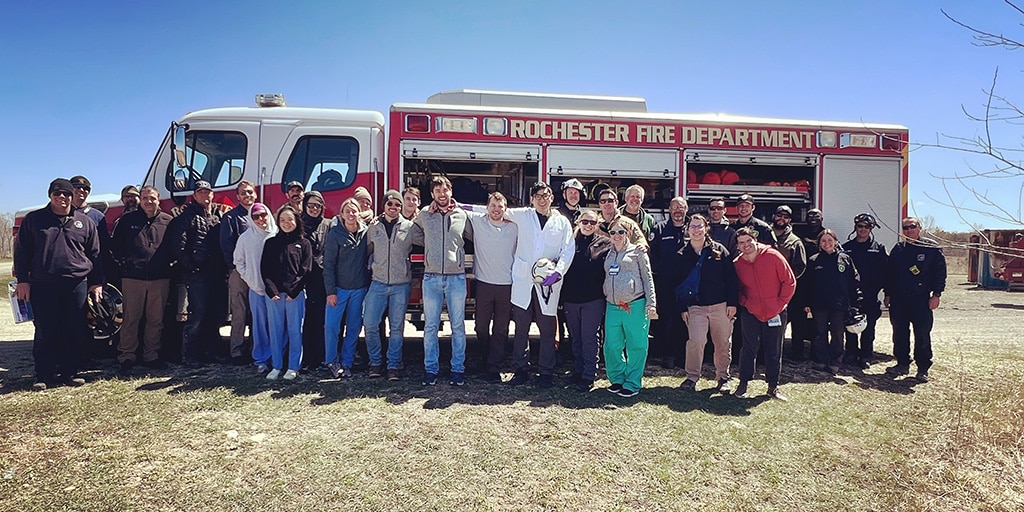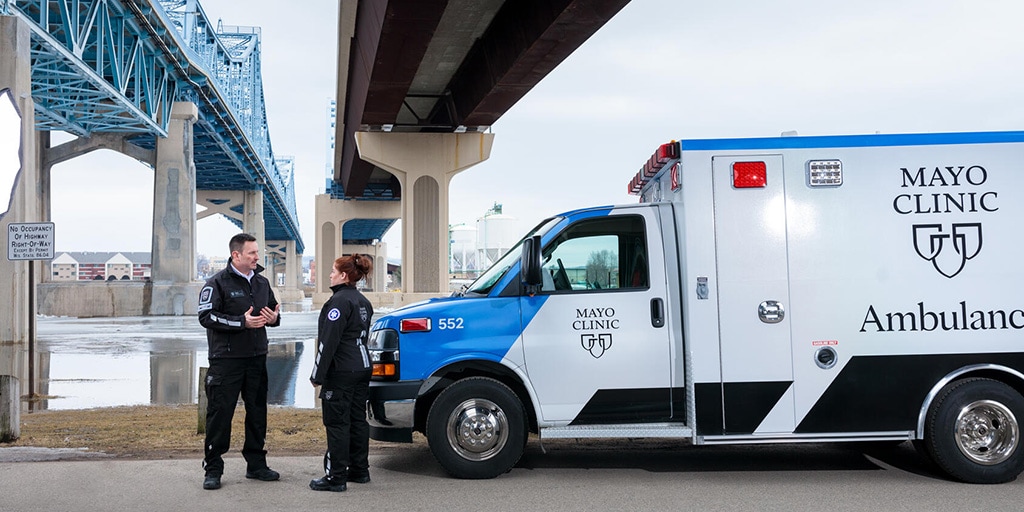Medical Education
There are numerous opportunities for the EMS fellow to interact with and provide medical education to trainees, to include medical students and residents from the Mayo Clinic Emergency Medicine Residency program, students of the Paramedic Program, as well as current EMTs, paramedics, firefighters, and law enforcement.
Mayo Clinic emergency medicine residents are exposed to a longitudinal EMS curriculum throughout their training, which provides ample opportunity for ride-alongs with EMS physicians regularly to learn more about EMS, prehospital care, and gain experience in medical direction. The EMS fellow will have opportunities to assist in medical education of emergency medicine residents by presenting during the residents’ didactics conferences. Prior topics have included reviewing online medical control calls, updates to MCAS protocol guidelines, and emerging topics in EMS. Additional teaching opportunities throughout the year include the Beyond ACLS course held for incoming interns, resident Olympics day, tactical medicine at the annual spring paintball retreat, and procedural labs.
EMS Day
Every April, the Division of Prehospital Medicine organizes an EMS Day for residents to provide hands-on exposure to EMS topics in a fun outdoor environment, in collaboration with local firefighters. The division has developed a three-year rotating curriculum consisting of HAZMAT (Year 1), structural collapse and confined-space medicine (Year 2), and vehicular extrication/fireground EMS (Year 3). The residents greatly enjoy this opportunity and look forward to playing outside in the mock-up trench or using Jaws of Life. The EMS fellow is involved in the planning and execution of this annual event.

Simulation
Mayo Clinic has a state-of-the-art Simulation Center that is a popular enhancement to the curriculum of emergency medicine residents. The EMS fellow is able to contribute substantially to the creation and implementation of an annual EMS-specific simulation held for the residents. If you have a particular interest in developing simulation expertise, you will be provided a unique opportunity to attend the Mayo Clinic Simulation Instructor Development: Comprehensive Course for free.
In addition to our formal simulation center, our department has developed a just-in-time clinical training area. In this area, we have several airway mannequins, a dedicated institutional airway cart, and GlideScope and C-Mac video laryngoscopy systems to practice and teach airway skills. lumbar puncture trainers, chest tube/pigtail trainers, as well as all of our departmental procedural kits allow for just-in-time review of procedures prior to performing them on patients or practice after the fact to hone skills and improve performance. This space is available 24/7 to all learners.
In 2021, the graduate school also developed a Procedural Skills Mastery Lab located just below our Emergency Department with a myriad of resources that you can use in drop-in fashion to develop and master core procedural skills, as well as teach them to others. The Mastery Lab’s focus is on mastery of the procedural skills. For example, procedures such as practicing suture skills, practicing central line placement, ECMO training, paracentesis, thoracentesis, and more.

Emergency Medicine Paramedic Program (EMPP)
The 20-month Emergency Medicine Paramedic Program (EMPP) is offered in collaboration between Mayo Clinic School of Health Sciences, Mayo Clinic Ambulance, and Rochester Community and Technical College (RCTC) in Rochester, Minnesota. It is designed to prepare students for a career as a paramedic. The EMPP consists of two cohorts per year, with each cohort having up to 20 students. A new cohort starts every August. Students may choose to attend the program in Rochester, Minnesota, or a satellite location in Duluth, Minnesota.
The Emergency Medicine Paramedic Program encourages physician involvement in its paramedics’ education. The medical director is actively involved in the curriculum and provides direction as needed. Many opportunities are available for EMS fellows to actively participate in this education. Each semester the program has lecture opportunities and active simulation education, during which physician involvement is vital. Many of the opportunities have skill components in addition to lectures and physicians have provided education in areas of patient assessment, pharmacology, cardiology, pulmonology, shock/trauma, medical emergencies, toxicology, endocrinology, pediatrics, and OB/GYN, to name a few.
There are multiple simulations and in situ scenarios that paramedic students engage in and having physician guidance during these simulations enhances the program. Physician evaluation of these scenarios has shown that students are better prepared to enter the field as critically-thinking paramedics. The program promotes physician involvement to empower the EMS student to provide the highest level of care and competency-based education.
Fellows have the opportunity to make a significant impact on paramedic student education and program staff are excited to have content experts be a part of the EMPP. Additionally, the EMS fellow will obtain their NREMT certification during their training and are invited to participate in practice sessions before their test, alongside paramedic students.
Care feedback and follow-up for EMS
Mayo Clinic leads the way in providing care feedback and patient follow-up to our first responders, both hospital and non-hospital affiliated. The EMS fellow will have ample opportunities to become involved in an existing process to provide both patient follow-up and feedback (run reviews).

Additional education and teaching opportunities
Opportunities are endless with prior fellows having been involved in teaching Rochester Police Department, Rochester Fire Department, and rural and volunteer-based EMS agencies. Additionally, fellows have been involved in teaching portable ultrasound to Mayo Clinic Ambulance flight crews and providing quality assurance of studies performed and recorded in the field.